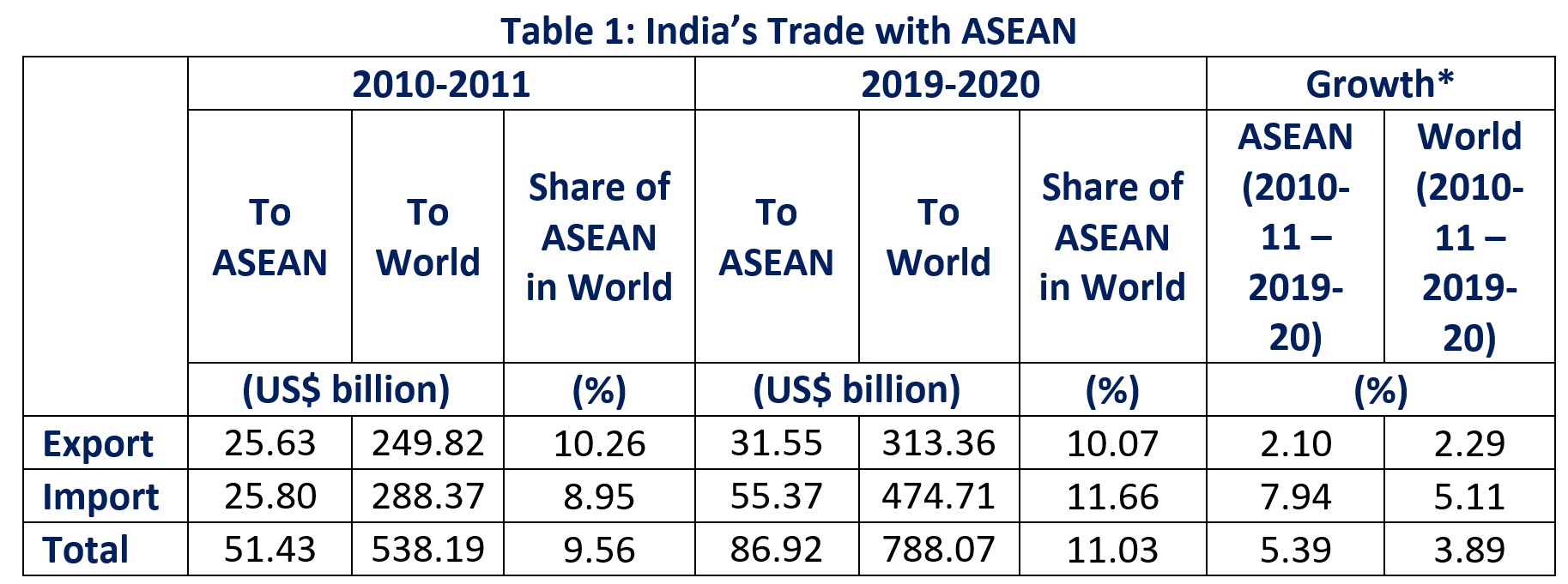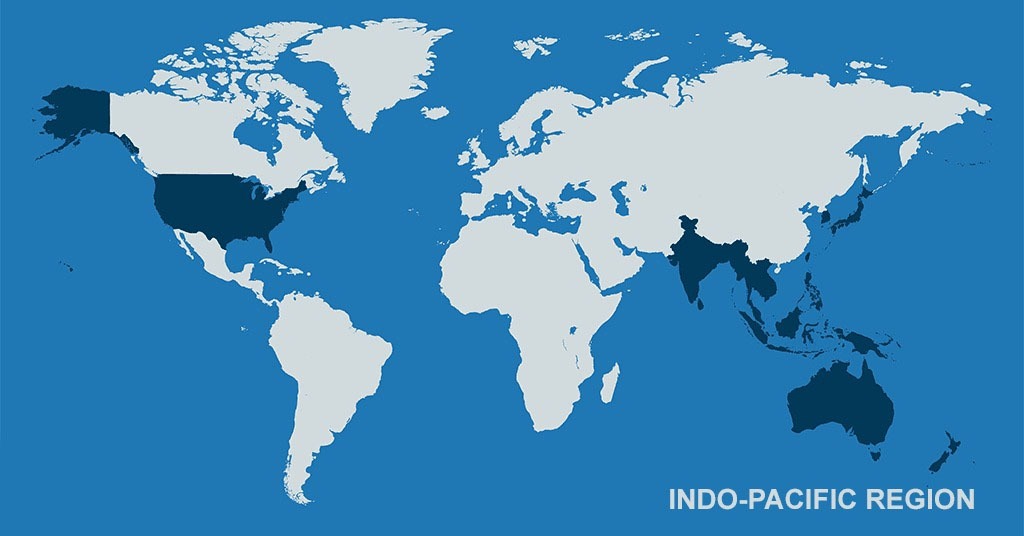The “Look East Policy” of strengthening India’s ties with the ASEAN was upgraded to the “Act East Policy” at the 12th ASEAN-India Summit in November 2014, by the Hon’ble Prime Minister Shri Narendra Modi. Strategic and trade experts consider this to be a landmark policy decision due to several factors. First, it widens the scope of the “Look East Policy’’ and covers strategic and security ties, along with economic, trade and people-to people connectivity. Infrastructure development, capacity building and cultural cooperation are key components of the “Act East Policy”. Second, the policy focuses on development of the North Eastern Region of India, as a gateway to South East Asia. Third, this policy tries to counter-balance the growing presence of China in the ASEAN region. Fourth, the policy support continuous engagement with Southeast and East Asian countries in different forums and at multiple levels: bilateral, regional and multilateral.
India’s relationship with ASEAN has been at the centre of India’s “Act East Policy”. The trade and strategic partnership between India and ASEAN have seen several successful milestones as both nations look forward to celebrating their 30 years of dialogue partnership in 2022. India became a sectoral dialogue partner of ASEAN in 1992. In 1996, this was upgraded to a full dialogue partnership. In 2002, India became a Summit level partner of ASEAN. In 2018, ASEAN and India commemorated 25 years of dialogue partnership and 15 years of Summit level partnership. The Commemorative Summit was attended by the Leaders from all the 10 ASEAN countries and came out with the Delhi Declaration, the guiding roadmap of the ASEAN-India partnership. At present, there are more than 30 senior official level interactions between India and ASEAN, cutting across all the sectors, and an annual summit of the Heads of the countries.
Economic Engagement
India and ASEAN represent a total population of around 1.8 billion, which is a quarter of the global population. Some of the world’s fast-growing emerging markets are in this region. With a total GDP of over US$ 3.8 trillion, the region presents one of the largest economic spaces in the world. In the past decade, India and ASEAN member states have seen a rapid growth in digitalisation and adoption of 4th industrial revolution (IR) technologies, which have been accentuated by the recent COVID-19-led pandemic. India’s digital economy is projected to be US$ 1 trillion by 2025, constituting around 18-23 percent of the gross domestic product (GDP). The digital economy of ASEAN is around 7 percent of its GDP and with digital integration across its member countries, it is projected to be US$ 1 trillion by 2025. Thus, both economies are expected to reach the same size by 2025.
India and ASEAN signed the free trade agreement (FTA) in goods in 2010 and bilateral services and investment agreement in 2015. India has comprehensive trade agreement with Singapore and Malaysia and an Early Harvest Agreement with Thailand. These agreements have helped to enhance trade between India and ASEAN. ASEAN is currently India’s fourth-largest trading partner, and India is ASEAN’s seventh-largest trade partner. Bilateral trade between ASEAN and India presently covers almost 11 per cent of India’s global trade, marginally improved by one per cent between 2010-11 and 2019-20 (Table 1). Adding China, Japan and Korea in it, countries falling under the coverage of Act East Policy (AEP), contribute to about one-third of India’s global trade. India’s trade with ASEAN has grown faster than India’s trade with the world.

Note: * compound annual growth rate (CAGR)
Sources: Author’s calculation based on Export-Import Data Bank, Department of Commerce, India; and De, Prabir (2020) Act East to Act Indo-Pacific, Knowledge World, New DelhiNote: * compound annual growth rate (CAGR)
I. Connectivity
Work on infrastructure connectivity projects such as the India-Myanmar and Thailand Trilateral Highway and its extension to Cambodia, Lao PDR, and Vietnam; and the Kaladan Multimodal transit transport projects is ongoing. An ASEAN-India Air Transport Agreement has been proposed and the ASEAN-India Maritime Agreement is also expected to be signed soon.
II. Challenges, Opportunities and Way Forward
To strengthen Digital Connectivity, in July 2017, India had announced a concessional Line of Credit of US$1 billion to develop connectivity infrastructure, both physical and digital, as part of its commitments for integration with ASEAN. It involved installation of a regional high-capacity fibre-optic network, supplemented by national rural broadband networks and digital villages in remote areas of ASEAN, among others. In January 2018, India announced a pilot project on rural connectivity in the CLMV (Cambodia, Lao PDR, Myanmar and Vietnam) countries at the ASEAN-India Commemorative Summit.
The COVID-19 pandemic impacted India and ASEAN and led to disruption of supply chains and trade flows. There is a growing protectionism around the world. One of the key challenges to India’s export is to maintain the competitiveness in the global and regional markets by improving trade facilitation not only at home but also with the trade partners. At the same time, the pandemic has also created opportunities for development of new supply chains and India has emerged as a key destination for foreign investment as companies try to relocate out of China. Measures like Production-linked Incentive (PLI) scheme is expected to help attract foreign investment. Digitalization of supply chain and trade facilitation have emerged as important areas for ASEAN-India cooperation. Another great opportunity to scale up the ASEAN-India engagements is the development of value chains.
An area of concerns for Indian businesses is that other trade agreements of ASEAN and its member states have better coverage and commitments, and therefore, Indian exporters do not have a level playing field. They also face non-tariff barriers. Both sides need to address the barriers and move forward towards enhancing economic engagement. There is a need to upgrade the ASEAN-India FTA (AIFTA) and deepen the coverage and depth of commitments. The effective utlisation of the AIFTA will add momentum to the bilateral trade flows, while promoting sustainable and inclusive growth for ASEAN and India. Both nations can work together to enhance engagements of small and medium enterprises in bilateral trade.
With countries such as the Australia, Japan, and the United States considering India’s role to be crucial in the Indo-Pacific, the ASEAN-India partnership has become the foundation of the Indo-Pacific. India’s “Act East” policy is evolving into “Act Indo-Pacific” policy. ASEAN, in June 2019, and India, in November 2019, came out with their respective Indo-Pacific visions, namely, the ASEAN Outlook on Indo-Pacific (AOIP) and the Indo-Pacific Oceans Initiative (IPOI), respectively. In this context, the ASEAN-India connectivity initiatives could serve as a basis for Indo-Pacific infrastructure cooperation. In the post-Covid-19, restoring connectivity and resilience of supply chains will be the key to ASEAN-India economic integration, particularly the development of India’s Northeast India. The recommendation of the ASEAN-India Plan of Action (POA) (2021-2025) must be implemented while India moves forward from “Act East” to “Act Indo-Pacific”.
(The Author is Professor ICRIER, New Delhi and member, Act East Forum, SPMRF, New Delhi. Author has benefitted from the discussion with Dr Prabir De, ASEAN-India Centre (AIC), RIS. Views expressed are personal. The author can be contacted at [email protected])
Image Source: ceoworld.biz
(The views expressed are the author's own and do not necessarily reflect the position of the organisation)

